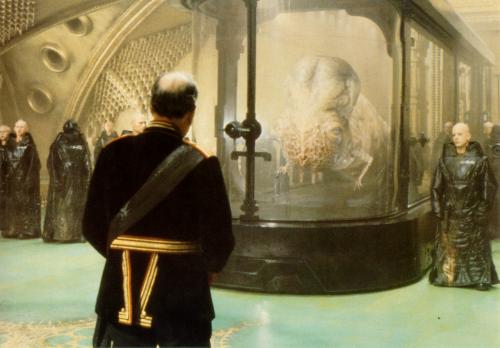 Earlier I wrote about what Damon Knight characterized as “a sense of wonder” that emerges at times in a science fiction story, or as in the case of this blog entry, in a movie. I said that the sense of wonder was “when we come across a scene or image or turn of phrase in a science fiction story that causes our imagination to make a sudden leap away from our normal cognitive boundaries and into a new realm.” And that realm triggers a visceral, gut reaction–usually one of pleasure and delight–and it’s called, in lieu of anything else, a “sense of wonder.”
Earlier I wrote about what Damon Knight characterized as “a sense of wonder” that emerges at times in a science fiction story, or as in the case of this blog entry, in a movie. I said that the sense of wonder was “when we come across a scene or image or turn of phrase in a science fiction story that causes our imagination to make a sudden leap away from our normal cognitive boundaries and into a new realm.” And that realm triggers a visceral, gut reaction–usually one of pleasure and delight–and it’s called, in lieu of anything else, a “sense of wonder.”
And it can happen in the movies.
This entry, as you can see from the photograph provided, is from the movie Dune. Now before you hit the ceiling and flame me to death for having such bad taste to even mention the movie Dune, let me just say that, yes, like everyone else on the planet, I hated it. However, I’m not inclined to throw out the baby with the bath water in this case. I thought the movie’s greatest flaw was the continual use of Herbert’s annoying interior-dialog (or thoughts) that the movie’s producers had everyone expressing every chance they got. Plus, some of the acting was downright embarrassing if not actually stupid. Sting didn’t need to be in the movie, but he was the flavor of the month at the time the movie was cast. And the actress who played Paul’s mother should have stayed back in Italy where she would be better known. (She got that part because much of the financing came from Italy and the money people always put in requirements that they use actors native to their country. Terry Gilliam had this problem in The Adventures of Baron Munchausen. The actress who played the moon goddess was Italian as well. Italy was a major source of money for that film.)
In any event, I thought the set decoration in Dune, the lighting (the visual mood of the film), to be astonishing. I liked the space ships and the scale of the movie as well. But what really took me by surprise was when the Third Stage Navigator appeared in the movie.
I was impressed because that was the point in the film that I had a real sense that this movie was really taking place 10,000 years from now: the way people dressed, the way they comported themselves, but especially the water-cage the Navigator was housed within–it all blew me away. I remember saying “wow” in a loud whisper in the theatre. This scene may not have gotten to you the way it did me, but so little science fiction these days captures that sense of the far future. That scene seemed palpably alien to me–that these might not be actual human beings (the Third Stage Navigator certainly wasn’t), but I really got the sense that this was what the far future would look like.
This is where set designers (and CGI techs) can outpace fiction writers. They can design something that’s hard to describe in writing that can give us a sense of the time. Like the two Sherlock Holmes movies (with Robert Downey, Jr. and Jude Law) can give us a sense of Steampunk London, so can science fiction movies give us moments (if not whole films) that can take us out of our usual mind-sets of what the future ought to be and knock us in the back of our seats. I thought Blade Runner did this throughout the whole film, but so much has been written about the effect of that movie that I won’t touch on it here. There are other moments in other movies that I’ll mention, but I thought I’d toss this one visual moment out from Dune . . . even if the move sucked big time.
–Paul Cook










